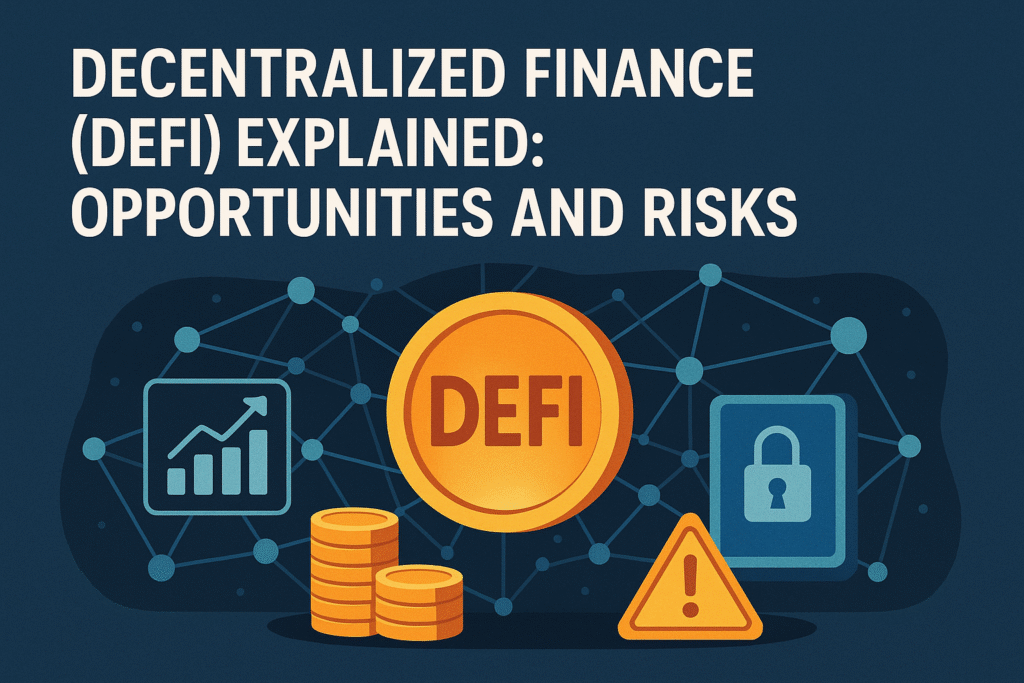Introduction
Decentralized finance (DeFi) is an umbrella term for financial services built on public blockchains that aim to recreate, improve, or replace traditional financial infrastructure in a permissionless, programmable way. Instead of banks, exchanges, or clearinghouses, DeFi relies on smart contracts—self-executing programs deployed on blockchains (most prominently Ethereum and other smart-contract platforms)—to enable lending, trading, payments, insurance, and more. Since its rapid growth in the late 2010s and early 2020s, DeFi has opened new possibilities for financial innovation while also exposing participants to novel technical and economic risks.
How DeFi works (high level)
– Smart contracts: Core business logic (lending terms, swap formulas, collateral rules) is encoded in smart contracts that run automatically when predefined conditions are met.
– Tokens and stablecoins: Native blockchain tokens and stablecoins (crypto pegged to fiat or other assets) are used for value transfer, collateral, and incentives.
– Automated Market Makers (AMMs): Decentralized exchanges like Uniswap use liquidity pools and constant product formulas to enable permissionless trading without order books.
– Lending/borrowing protocols: Platforms such as Aave or Compound allow users to deposit assets to earn interest and borrow against collateral, with liquidation mechanisms enforced by contracts.
– Oracles: Off-chain price feeds (e.g., Chainlink) provide external data to smart contracts so they can make correct decisions about valuations and liquidations.
– Governance and tokens: Many protocols issue governance tokens that grant holders voting rights and influence over protocol parameters and upgrades.
– Composability: DeFi building blocks can be combined—“money legos”—allowing developers to stack services (e.g., borrowing on one protocol to provide liquidity on another).
Opportunities
– Financial inclusion: Permissionless access means anyone with an internet connection and a wallet can use financial services without traditional bank accounts, credit checks, or intermediaries.
– Innovation and rapid iteration: Open-source protocols enable fast experimentation—new financial products, synthetic assets, automated strategies, and cross-border payment tools.

– Higher yields and new income streams: Yield farming, liquidity mining, and algorithmic strategies can generate returns that are often higher than traditional savings products (but with commensurate risk).
– Reduced counterparty and intermediary costs: Smart contracts automate enforcement, settlement, and custody, potentially lowering fees and time delays.
– Programmability and new financial primitives: Tokenization, composable derivatives, on-chain insurance, prediction markets, and automated payroll are examples of novel use cases.
– Transparency and auditability: Public blockchains provide verifiable transaction histories, making protocol behavior observable (though interpreting on-chain data requires skill).
Risks
– Smart contract vulnerabilities: Bugs in contract code can lead to loss of funds. Many high-profile exploits and flash-loan attacks have drained protocols despite audits.
– Oracle manipulation: If price feeds are compromised or delayed, protocols can make incorrect liquidation or settlement decisions, leading to losses.
– Rug pulls and governance attacks: Malicious teams can abandon projects, or attackers can exploit poorly designed governance to control funds or upgrade contracts maliciously.
– Liquidity and market volatility: Crypto markets are highly volatile. Liquidations in leveraged positions and sudden price swings can cascade losses across protocols.
– Impermanent loss and AMM risks: Liquidity providers can experience impermanent loss when asset prices diverge, sometimes outweighing earned fees.
– Centralization and custodial risks: Some DeFi components (e.g., oracles, key multisigs, cross-chain bridges) have centralized points of failure that can be attacked or censored.
– Bridge and cross-chain risk: Bridges that move assets across blockchains are frequent targets for hacks and have lost large sums historically.
– Regulatory uncertainty: DeFi operates in a gray area in many jurisdictions. Future regulation could affect access to services, taxation, KYC/AML requirements, or even the legality of certain tokens.

– Front-running and MEV (Maximal Extractable Value): Transaction reordering by miners/validators or bots can extract value from users’ transactions (e.g., sandwich attacks on swaps).
– User operational security: Loss of private keys, phishing, and connecting wallets to malicious dApps can result in irreversible loss.
Risk mitigation and best practices
– Do your own research (DYOR): Read whitepapers, audits, community discussions, and verified code when available. Understand the protocol’s economics, upgrade paths, and tokenomics.
– Start small and diversify: Limit exposure to any single protocol or strategy, and avoid overleveraging.
– Prefer audited and battle-tested protocols: Audits reduce, but don’t eliminate, risk. Look for reputable teams, transparent multisig governance, and community scrutiny.
– Use hardware wallets and secure key practices: Store private keys offline where possible; avoid sharing seed phrases or signing transactions blindly.
– Understand liquidity and token pair dynamics: For liquidity providers, calculate impermanent loss potential and compare it to expected fees or incentives.
– Watch oracle design and collateralization: Protocols that rely on decentralized, redundant oracles and conservative collateral ratios are generally safer.
– Consider insurance and socialized risk options: Some platforms or third-party insurers provide partial coverage for specific smart-contract risks.
– Keep software and browser extensions updated, and verify dApp URLs to avoid phishing.
Practical use cases

– Lending and borrowing: Users earn passive income by supplying assets and can access liquidity by borrowing against collateral.
– Decentralized exchanges and swaps: Permissionless trading of tokens with near-instant settlement and no centralized custody.
– Stablecoins and payments: Stablecoins enable programmable payments, cross-border transfers, and a medium of exchange in crypto-native economies.
– Tokenized assets and synthetics: Real-world assets (RWA) and synthetic derivatives on-chain expand access to commodities, equities, and fixed-income exposure.
– On-chain insurance and risk markets: Peer-to-peer or protocol-based insurance products can hedge specific DeFi risks.
– Automated investment strategies: Yield aggregators and vaults automatically rebalance and optimize strategies for users.
Regulatory and systemic considerations
DeFi’s growth raises questions for policymakers and institutions: how to apply securities, commodities, and anti-money laundering laws; how to protect retail users without stifling innovation; and how to integrate DeFi with existing financial systems. The regulatory landscape will likely shape which DeFi models scale broadly, and may push some services to adopt KYC, audits, or hybrid designs.
Outlook
DeFi continues to mature. Improvements in smart contract security, cross-chain interoperability, oracle robustness, and user experience can reduce some risks over time. Institutional interest may bring more capital, professional custody solutions, and regulatory clarity—but potentially also more centralization and compliance constraints. The most durable innovations will likely be those that combine transparency, composability, and robust economic design while addressing user and regulatory concerns.
Conclusion
DeFi offers transformative opportunities: more accessible financial services, programmable money, and composable financial products. Those opportunities come with real and sometimes novel risks—from technical exploits to economic fragility and unclear legal frameworks. Participants should approach DeFi with a mix of curiosity and caution: educate themselves, use strong operational security, prefer established protocols, limit exposure, and stay informed about evolving risks and regulations. For developers and policymakers, the challenge is to preserve DeFi’s openness and innovation while building the safety and resilience required for broader adoption.

